Unexplored Opportunities: Multi-Sector Strategies for Collaboration in Underwater Unexploded Ordnance Remediation
Multi-Sector Strategies for Collaboration in Underwater Unexploded Ordnance Remediation
CISR JournalThis article is brought to you by the Center for International Stabilization and Recovery (CISR) from issue 25.2 of The Journal of Conventional Weapons Destruction available on the JMU Scholarly Commons and Issuu.com.
By Chris Price [ Oklahoma State University ]
Few global challenges are as ripe for multi-sector collaboration as underwater (UW) unexploded ordnance (UXO) remediation. Millions of metric tons of UXO are lying on and under the seabed corroding, decaying, and seeping toxic chemicals into the ecosystem—ultimately ending up in our food. Because most underwater UXO are from WWI and WWII, and given the corrosion rates of most metals from which ordnance is made, the inevitable problems with ordnance dumped, sunk, and fired into bodies of water (mostly in coastal regions) are catching up with us. The urgency is exacerbated by biochemical changes in oceans due to climate change that increase rates of corrosion and other processes. Meanwhile, maritime technologies in several sectors have reduced the barrier of entry even for small companies and nongovernmental organizations (NGOs) to partner with militaries, corporations, and nations, large and small. With combined resources, expertise, and knowledge, these partnerships can remediate the ecological, economic, explosive, and human health hazards caused by underwater UXO. While some technological gaps exist in detection, disposal, and removal operations, the most significant barriers are political and economic. Nevertheless, multi-sector collaboration combined with innovation from maritime and explosives experts offers some unexplored opportunities to increase health, wealth, and safety for all.
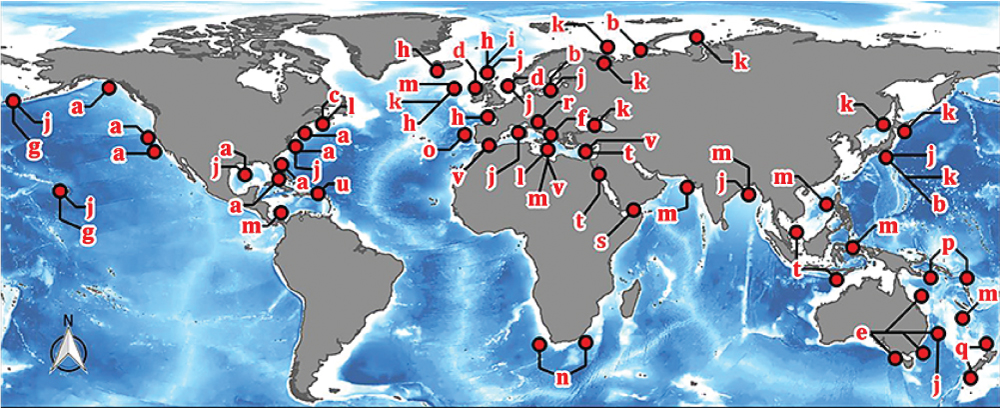
Figure 1. Documented marine sites with munitions present include conventional weapons, chemical weapons, and UXO. Note that the map resolution is coarser than the number of actual munitions dumps, e.g., the letter h has 148 UXO dumpsites. Figure courtesy of Frontiers in Marine Science.1
Why UW UXO? Why Now?
Underwater ordnance presents obvious hazards to fishermen, divers, vessels, and others in coastal regions. While some are unlikely to detonate if they were dumped from storage configurations as a means of disposal, other UW UXO sites contain missiles, torpedoes, mines, bombs, and other munitions that were once fired but failed to function as designed—these present the greatest risk, since small disturbances could result in catastrophe. Even dumped ordnance, however, leaks toxic chemicals from hydrocarbon compounds such as RDX and TNT. These chemicals and byproducts (after partial decomposition in the local areas) result in lethal reactions with the surrounding ecosystem that affect coral, marine mammals, and fish. In turn, these point source contaminants get into the local human population’s food supply, particularly in coastal regions, which tend to rely heavily on seafood. If the perceived threat to public health spreads, contaminated food supplies could result in economic devastation that would wipe out the entire fishing industry.
Over the last few decades, the urgency has increased to a point that health and economic risks will reach national or even regional levels. This increase in concern is due primarily to two factors: (1) increased industrial activity in the maritime environment (offshore wind farms, dredging, and laying of seabed infrastructure); and (2) the corrosion rates of metals used for ordnance casings.
Approximately eighty years have passed since countries dumped WWII UXO and one hundred years since countries dumped WWI UXO and chemical weapons. Given corrosion rates of carbon steels, aluminum, and other relevant metals encasing these hazards, what used to be inevitable is now imminent. According to a 2018 study in Indonesia involving university and government scientists analyzing corrosion in steel and galvanized steel, corrosion rates are often logarithmic with higher initial rates until a steady state rate is achieved. For example, for the first month, galvanized steel can corrode between 7 and 9 mm per year (mpy) and mild steel can corrode as quickly as 25.5–29.5 mpy.3
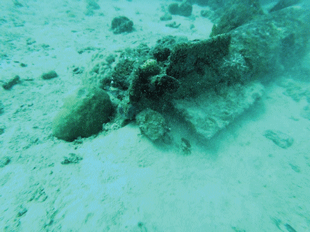
Figure 2. Underwater UXO survey by NGOs in the Pacific Ocean.Figure courtesy of Chalres Brown, Platinum East.
After that initial period with higher corrosion rates, an oxide film forms due to cathodic and anodic reactions, as well as biological growth, so the rate stabilizes for years or decades.4 For steady state corrosion rates after the oxide film forms, several studies corroborate approximately 0.1 mpy of corrosion on metals such as steel.5,6,7 Thus, the majority of UXO, chemical weapons, and related hazards likely have between 8 and 10 mm of deterioration due to steady state corrosion over 80 to 100 years in addition to what the initial higher rates produced. A typical UXO such as the 122 mm OF-462 projectile in Figure 3 has a wall thickness ranging from a couple millimeters up to 15 or more millimeters.8 Assuming worst case conditions, WWII UXO dumped in 1945 could already have corroded sufficiently to result in toxic chemical leakage in the 1950s, with a more reasonable estimate ranging from 80 to 150 years for most ordnance. Other factors also play a role in determining corrosion rates such as depth and salinity, as well as pH, which recently has increased due to climate change and ocean acidification, which in turn increases the rates of reaction involved in corroding ordnance shells.9
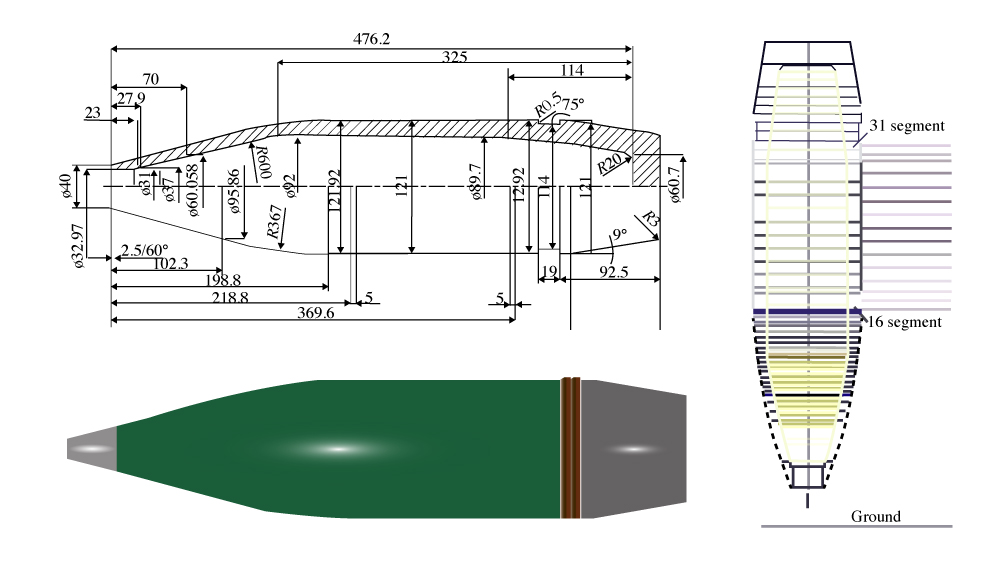
Figure 3. Dimensions of 122 mm OF-462 projectile. Figure courtesy of Defence Technology. 2
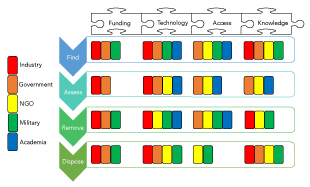
Figure 4. Multi-sector assessment of underwater UXO assets and capabilities. The colors presented indicate which sector has a significant strength or advantage in that attribute. Figure courtesy of the author.
Even with reliable models, in situ measurements of oceanographic conditions and ordnance reconnaissance from trained experts are critical. Corrosion rates (and therefore the data to feed risk analysis) are based on variables such as water depth, bathymetry, temperature, salinity, dissolved oxygen levels, pH, conductivity, sediment transport conditions, tidal and current activity, presence of bio-deposits, and exposure to climatological changes.This variability of conditions in underwater UXO remediation emphasizes the importance of corporations and governments—who have resources and personnel to do large area sweeps to localize UXO sites and collect imagery—to partner with universities, NGOs, and local governments who have historical knowledge of a particular area of interest.
One example of universities and NGOs partnering is demonstrated by the recent establishment of the Oklahoma State University (OSU) Institute for Global Explosive Hazard Mitigation. OSU is partnering with Johns Hopkins University, Golden West Humanitarian Foundation, Platinum East, and Bomb Techs Without Borders to conduct research in EOD tools, provide post-conflict trauma support, and even conduct explosive remediation operations of ground and underwater threats. While striving to make the world safer, the partnerships create an environment for students and practitioners to develop themselves through graduate education, meaningful research, and global networks of experts.10
The Whole Is Greater Than the Sum of the Parts
It is tempting to blame the militaries of the world for dumped munitions. They developed, tested, and discarded UXO, munitions filled with chemical agents, and other hazards throughout preparation for war and in peace time as items became expensive to store and eventually unserviceable. The reality is that militaries do not have the “capacity, skill set, funding, or mandate” to assess environmental hazards of underwater UXO, prioritize remediation, and unilaterally execute removal and disposal procedures.11
NGOs dedicated to the removal and remediation of UXO do have the mandate and skillsets to focus on the problem but often lack the capacity and funding. Governments do not always include mitigation of environmental hazards directly or indirectly derived from underwater UXO; however, the UXO often originates from nations whose governments do have the funding. Furthermore, many militaries apply (or could apply) substantial resources toward the problem. Alternatively, whereas large companies from the private sector such as those in the oil and gas industry do not have the incentive to remove UXO since there is little profit in doing so, they do have the funding to finance remediation efforts as well as the skillsets in subsea and seabed detection technologies. Many tools such as synthetic aperture sonar (SAS), magnetometers, gradiometers, magnetic anomaly detector (MAD), and sub-bottom profilers are used in infrastructure maintenance and natural resource exploration. Their surface platforms and unmanned systems also have the skillsets and capacity to conduct large-scale remediation operations with sufficient standoff to minimize risk to personnel.
For removal or disposal, environmental groups and local governments are often concerned that countercharging UW UXO will result in worse problems such as irreversible damage to coral and other marine life. However, other technologies have been explored and some are quite mature with years or decades of datapoints. To minimize blast effects from ordnance disposal by countercharge, divers can place bubble curtains around the detonation site, especially between the site and any nearby marine life or property. The bubbles escaping a pressurized hose have significant blast effect reduction such that coral, fish, or infrastructure located meters from a detonation site even in the hundreds of kilograms can have an exponentially higher probability of survival after the detonation.12 Sometimes local or state governments decide to leave hazards in place, which may have made more practical sense twenty years ago when search and removal technologies were less mature and corrosion was less likely. For example, the state of Hawaii’s Department of Land and Natural Resources announced in 2020 that it will wait until nonexplosive removal options are available to remove hundreds to thousands of tons of ordnance in a crater off the coast of Maui used as bombing practice by the US military in WWII, citing concerns from environmental groups, lawmakers, and community members about the coral and marine life near the Molokini Crater.13 However, combining expertise from industry, military, and academia on various low-tech solutions for explosive and chemical hazards can lead to removal of ordnance in a way that is safe to people, wildlife, and the environment.14
Because no single sector has all the financial resources, technological expertise, access, placement, authorities, and local knowledge of underwater UXO on a global or regional scale, multi-sector collaboration is critical.
Each sector has their strengths. Maritime industries such as oil and gas corporations have copious amounts of funding and modern technologies for search and detection.
Various companies have vast capacities to finance NGOs, academic studies, and governmental or military efforts in underwater UXO remediation; indeed, some even have the fiduciary responsibility since unintended consequences (detonation, toxic leakage into the ecosystem) would not be in the best interest of companies’ shareholders. UW UXO remediation may be the primary mission for some companies or just one division of operations. Frequently, companies form strategic partnerships for either a single project or enduring relationships.15
|
# Commonalities |
Industry |
Government |
NGO |
Military |
Academia |
|
Industry |
- | 9 | 6 | 9 | 3 |
|
Government |
9 | - | 8 | 9 | 6 |
|
NGO |
6 | 8 | - | 8 | 6 |
|
Military |
9 | 9 | 8 | - | 4 |
|
Academia |
3 | 6 | 6 | 4 | - |
|
Figure 5. Homophily16 of underwater UXO sectors' attributes. Figure courtesy of the author. |
|||||
Governmental bodies (for purposes of this analysis, excluding the military and defense departments) have the knowledge and access to assess public health hazards to the ecosystem and food supply. It may even be a politically beneficial policy to improve remediation efforts on UXO since coastal nations rely heavily on the fishing industry for economic development.
NGOs offer significant value in access and knowledge based on their sustained presence in a region as well as persistent investment (in time, money, and people) in a particular UXO site. There are even technological advantages NGOs have used, born primarily out of a culture of operating and innovating in financially constrained organizations. Academic institutions offer search and detection technologies, novel means of UXO removal, and a wide array of environmental assessment technologies and techniques.
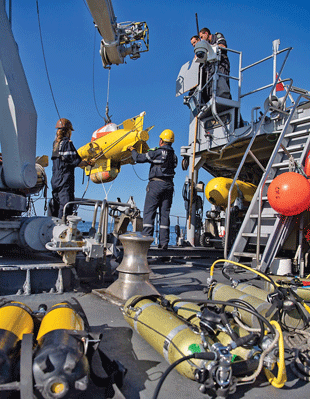
Figure 6. SNMCMG1 conducts HODOPS in France. Figure courtesy of NATO.19
While there is likely a company, NGO, or military that has attributes in each of the categories (funding, technology, access, and knowledge) for each of the fundamental phases of underwater UXO remediation (find, assess, remove, dispose), Figure 4 offers an analytical framework to assess the problem from a multi-
sector perspective. While this chart is notional based on a literature review on a broad, international scale, analysts and practitioners can use this framework on a regional, national, or local level to assess where industry, government, military, NGO, and academic organizations have strengths and weaknesses in different areas.
More importantly, once an assessment is completed at the appropriate level for single or multiple UXO sites, collaboration plans will help optimize resources, authorities, and expertise. For example, based on the multi-sector assessment from Figure 4, the chart in Figure 5 totals the number of common areas in which each sector has similar strengths or the homophily16 of each sector’s attributes in relation to the others. The highest numbers show the intersection of two sectors that should share best practices, such as government/industry and military/industry, since they have similar strengths but have different missions. The lowest scores such as industry/academia and military/academia indicate that these groups may not always have the most overlap in strengths; therefore, they must work together the most in order to leverage complimentary resources, expertise, access, and technology.
A recipe for success that has been demonstrated by strategic partnerships usually has several key ingredients:
- local governments and stakeholders interested in supporting explosive ordnance disposal (EOD) efforts and providing local knowledge and access to UXO/EOD technicians
- NGOs with a long-term presence in areas that also have local knowledge of the UXO sites and have developed relationships with local populations, governments, and industries
- militaries, and/or international coalitions (i.e., NATO) providing EOD and UXO technicians with dive capabilities and autonomous or towed survey equipment, explosive charges, and other key matériel for operations
- industry partners providing financial support to NGOs and local governments, and matériel for the UXO remediation effort
- academia from nearby or international universities collecting environmental and survey data for analysis to assess hazards and progress throughout remediation operations as well as developing new technologies and techniques (often funded by governments and industry)
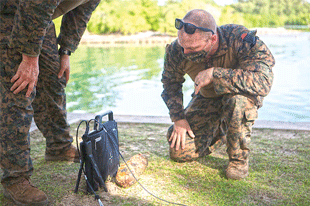
Figure 7. U.S. Marine Corps Littoral Explosive Ordnance Neutralization (LEON) assets remove WWII ordnance from littoral zones in the Republic of Palau as part of a Humanitarian Assistance Survey Team.21 Figure courtesy of United States Marine Corps. 22
This mixture of different sectors all providing their own strengths does not imply that all NGOs are poorly funded, or that militaries cannot also have long-term presence. But militaries tend to utilize forces in exercises and deployments for UW UXO remediation, but not usually for full, multi-year tours, especially in remote locations. Nevertheless, organizations such as NATO leverage resources, platforms, and professionals to conduct historical ordnance disposal operations (HODOPS) such as in Figure 6, which included U.S. (EOD Mobile Unit 8), French, Portuguese, and Latvian navies disposing of WWII bottom mines, some of which were found by local fishermen.17 Other times, in the course of laying telecommunications cables in which dredging operations uncover UXO, corporations will provide funding to private UXO companies or NGOs to clear the hazards prior to continuing development.18
In the Asia-Pacific, arguably the most heavily littered region for UW UXO, various components of U.S. EOD forces collaborate with allies and partners, as well as NGOs, to clear ordnance as safely as possible for both personnel and the environment.20
Conclusion
First, consider technical factors of ordnance corrosion, biochemical consequences of explosive fillers once leaked, and oceanographic processes in vicinity of the UXO site to prioritize operations. In general, corrosion will be faster when pH is higher, the site is in shallower water, and tidal activities are rapid.
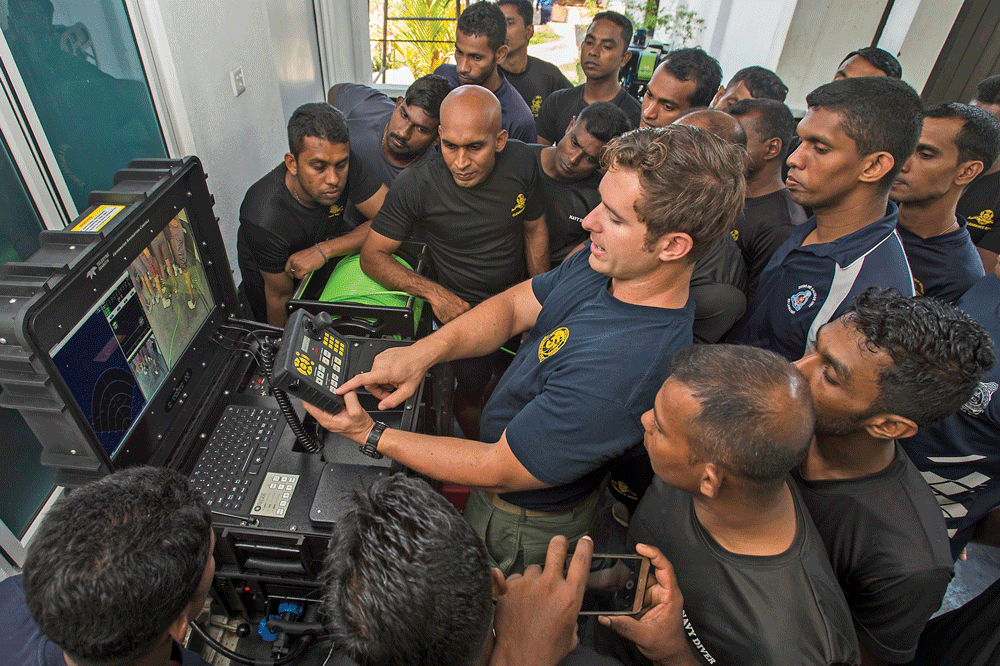
Figure 8. U.S. Navy EOD Mobile Unit 5 technician operating a remotely operated vehicle during humanitarian mine action operations with Sri Lanka Navy partners. Figure courtesy of United States Navy.23
Second, when forming a coalition across sectors to reduce UW UXO, first conduct an assessment at the appropriate level and scope. For a local region or single site, assess NGOs, industries, and nearby EOD assets to see who has resources, expertise, technologies, and access to quickly remediate the highest risk items. Leverage governments and academic institutions for environmental assessment methods to both prioritize operations and monitor progress throughout remediation efforts. NGOs are usually in the business of developing local relationships and staying in an area for extended periods of time (sometimes decades), and can use their access and knowledge to quickly find UXO sites and utilize local labor, resources, and innovative techniques from recognized experts in the field. Oil, gas, telecommunications, and other industries offer financial resources (either as a benefactor for philanthropic purposes or as a resource sponsor due to mutual interests in clearing UXO) as well as relevant technologies such as searching equipment and vessels.
Finally, militaries offer expertise in EOD operations, searching equipment, explosive materials for countercharging, and a clearly defined mandate to dispose or remove explosive hazards. When these various parties learn from each other when their capabilities overlap, and partner on projects when their capabilities do not overlap, optimal utilization of resources can lead to less unintended detonations from fishing activity, less toxic chemicals in the water, cleaner fish for the population’s food supply, and more economic activity for the region. It just takes some innovation and willingness to collaborate with nontraditional partners to get after it.
 Chris Price
Chris Price
Oklahoma State University
Chris Price is a Ph.D. candidate in Explosives Sciences at Oklahoma State University. His previous graduate studies also include Ocean Policy at the University of Hawaii and a MS in Mechanical Engineering with a focus on undersea technologies and operations.

